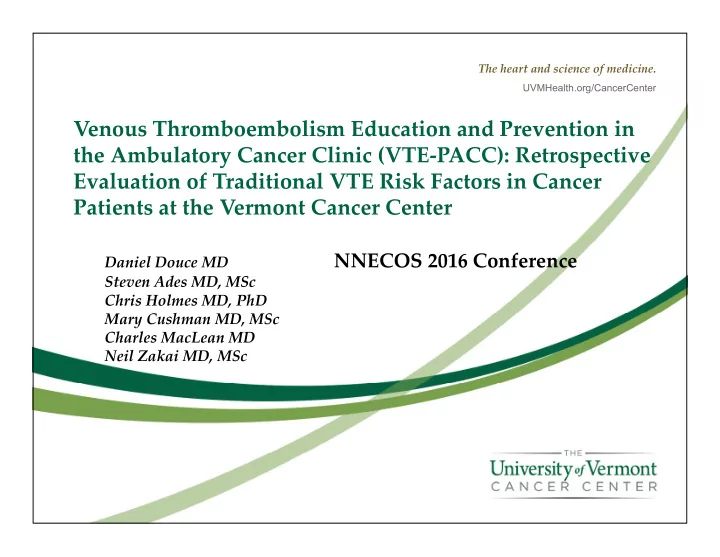

The heart and science of medicine. UVMHealth.org/CancerCenter Venous Thromboembolism Education and Prevention in the Ambulatory Cancer Clinic (VTE ‐ PACC): Retrospective Evaluation of Traditional VTE Risk Factors in Cancer Patients at the Vermont Cancer Center NNECOS 2016 Conference Daniel Douce MD Steven Ades MD, MSc Chris Holmes MD, PhD Mary Cushman MD, MSc Charles MacLean MD Neil Zakai MD, MSc
Disclosures No disclosures to report 2
Background • Individuals diagnosed with cancer have a high risk of developing Venous Thromboembolism (VTE) • Khorana et al were instrumental in publishing a prediction model for VTE 1 but has several limitations: – Convenience sample using limited and so may not represent a broad range of cancer patients – Does not include traditional VTE risk factors such as past history of VTE, Male Sex, or VTE triggers such as hospitalization or surgery 3
Khorana score & Protecht modification² Patient characteristic Points Very high risk cancer (stomach, pancreas) 2 High risk (lung, lymphoma, gynecologic, bladder, testicular 1 Pre‐chemotherapy platelet count 350 x10⁹ /L or more 1 Hemoglobin level less than 10 g/dl, or use of red cell growth factors 1 Pre‐chemotherapy leukocyte count more than 11 x10⁹ /L 1 BMI 35 kg/m² or more 1 Score ≥3=high risk, 2=intermediate risk, 0‐1=low risk Protecht score modification to Khorana score Points Chemotherapy used is platinum OR gemcitabine based 1 Chemotherapy used is BOTH platinum AND gemcitabine based 2 chemotherapies Khorana score generated above X High risk: Score ≥3, Intermediate and low risk: Score 0‐2 4
Aim Determine to what extend traditional risk factors for VTE, such as age, sex, prior VTE, and recent hospitalizations apply to people with cancer 5
Methods • Retrospective cohort study of all individuals with cancer starting chemotherapy at University of Vermont Cancer Center from 2012-2014 were used • VTE defined as pulmonary embolism or thrombus in the deep veins of the arms and legs, internal jugular veins, portal vein thrombosis, and superficial thrombophlebitis treated with full anticoagulation • Prior VTE defined as occurring more than 90 days prior to starting chemotherapy 6
Methods, cont. • VTE case ascertainment: VTE screened for using ICD-9 codes and confirmed by clinical chart review. • Statistical analysis: – Cox proportional hazard models were used to determine the hazard ratio (HR) and 95% confidence interval (CI) of traditional risk factors for incident VTE accounting for age, sex, BMI, and prior history of VTE. – Time Varying Covariates were used to assess VTE risk during and after hospitalizations 7
Results • Among 2,035 eligible patients, 190 developed VTE (9.3%) with available records VTE during study No VTE P period Mean Age 58 61 0.002 Percent Male 43% 53% 0.006 Mean BMI 31 33 0.02 Percent with BMI 23% 30% 0.03 >35 Most common Breast (14%) Lung (14%) cancers Lung (10%) Colorectal (12%) Non-Hodgkin lymphoma Non-Hodgkin (9%) Colorectal (7%) lymphoma (12%) Pancreas (8%) 8
Results 56% of VTE events occurred within 4 months of starting chemotherapy 9
Prior VTE Kaplan-Meier survival estimates 1.00 0.75 0.50 No Prior VTE Prior VTE 0.25 0.00 0 365 730 1095 Days after starting chemotherapy Hazard Ratio for prior VTE 95% CI p Unadjusted 2.21 1.39, 3.50 <0.001 Adjusted for Age, Sex 1.84 1.14, 2.96 0.012 10
Age, Sex, BMI Variable Hazard Ratio 95% Confidence P Interval Age (per 10 years 1.20 1.09, 1.35 <0.001 older) Male Sex 1.59 1.18, 2.15 0.002 BMI >35 1.41 1.02, 1.95 0.029 • Each variable adjusted for the other variables • Values for Age and BMI were both taken from the beginning of chemotherapy 11
Hospitalizations Non-Surgical Admission Period of Observation Hazard Ratio* 95% CI P Hospitalization only 2.08 0.85, 5.08 0.11 Hospitalization + 30 days 3.68 2.51, 5.37 <0.001 Hospitalization + 90 days 3.39 2.43, 4.71 <0.001 • In this population, 1819 hospital admissions occurred among 673 of these patients *all values adjusted for age and sex 12
Hospitalizations Surgical Admission Period of Observation Hazard Ratio* 95% CI P Hospitalization only 2.24 0.31, 16.02 0.42 Hospitalization + 30 days 2.10 0.78, 5.68 0.14 Hospitalization + 90 days 1.93 0.90, 4.14 0.09 • Of the hospital admissions, 251 had surgeries and occurred in 130 patients *all values adjusted for age and sex 13
Limitations • Retrospective Data: Administrative database using ICD-9 codes: chance of misclassification • Limited to patients starting chemotherapy, not all cancer patients • Could not adjust for performance status • Relatively few patients receiving surgery • VTE events at outside hospitals may have been missed • Single institution study 14
Conclusions & Future Directions • Traditional VTE risk factors, including older age, male sex, prior VTE, are all significant risk factors in cancer patients in developing VTE. • Post-hospitalization period in particular was a period of significantly increased risk in the setting of already elevated VTE risk • UVM Cancer center VTEpacc program – Prospectively collect patient information – Will be able to compare traditional risk factors with Khorana score 15
References 1. Khorana AA, Kuderer NM, Culakova E, Lyman GH, Francis CW. Development and validation of a predictive model for chemotherapy-associated thrombosis . Blood. 2008 May 15;111(10):4902-7 2. Verso, Melina, Giancarlo Agnelli, Sandro Barni, Giampietro Gasparini, and Roberto LaBianca. 2012. “A Modified Khorana Risk Assessment Score for Venous Thromboembolism in Cancer Patients Receiving Chemotherapy: The Protecht Score.” Internal and Emergency Medicine 7 (3): 291–92. doi:10.1007/s11739-012-0784-y 16
Acknowledgements • Jeffords Institute for Quality, The UVM Medical Center • Lake Champlain Cancer Research Organization Inc. 17
Recommend
More recommend